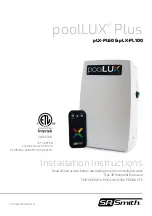
LAARS Heating Systems
Page 16
SECTION 6.
Operating Instructions
6.1 Sequence of Operation
The amber “Ready” light on the front panel
indicates that the control system is energized. Upon a
call for heat from the pool temperature control, the
green “Heat” indicator on the front panel will light.
The green “Pump” indicator on the front panel
will light.
Once the water flow switch makes, and if all of
the safety interlocks are closed, the ignition module(s)
will energize the blower(s) for a 15-second pre-purge,
followed by a 20-second period to allow the ignitor(s)
to heat.
Energizing the blower pressurizes the air box
(which supplies air to the burners) and closes the
normally-open contact(s) of the airflow pressure
switch(es). This allows the ignition module to proceed
with the ignition sequence.
The blocked flue pressure switch senses the
pressure difference between the exhaust plenum and
the blower inlet plenum. It will interrupt the airflow
sensing circuit if this pressure exceeds a maximum
value. If airflow is not proven, the ignition module
will either attempt ignition again (up to three times) or
will lockout (if the optional lockout ignition module is
used).
The ignition module checks that the ignitor
current has reached a minimum value and energizes
the gas valves at the end of the ignitor-heating period.
The green indicators on the front panel will light,
indicating that the gas valves are open.
After a 4-second trial for ignition, the ignitor
switches off, and unless the flame sensor detects a
flame, the gas valves will close and the ignition
module will either attempt ignition again (up to three
times) or will lockout (if the optional lockout ignition
module is used).
Note: at this point, if gas pressure is
below the required 5" w.c. minimum, the pool heater
will lock out.
If flame is sensed, the burner will continue to fire
as long as there is a call for heat. Pennant 1250, 1500,
1750 and 2000 models start at part load. When the gas
valves controlled by the first ignition module are
energized, the second ignition module is energized and
enters the same ignition sequence just described. If
there is a subsequent loss of flame signal, the burner
will attempt re-ignition up to three times (only once if
optional lockout ignition module is used.) Loss of
flame signal from the first ignition module will cause
shutdown of the heater.
When the call for heat is satisfied, the gas valves
close and the blower(s) continues to run for 30
seconds. The pump will continue to run for the length
of time selected at startup by the adjustment of the
pump time delay (Pd).
5.3.4 Differential - dLS
The differential (dLS) is the number of degrees
between the temperature at which the heater turns off
and the temperature at which the heater restarts. It is
adjustable from 1° F to 10° F.
5.3.5 Pump Operation
The pump energizes when there is a heat demand.
5.3.6 Heater Purge (Pump Delay) - Pd
After a demand is satisfied, the pump will
continue to run for a preset length of time. That length
of time is adjustable from 0.1 to 10 minutes and is
programmed by the parameter Pd.
Caution
Should overheating occur or the gas supply fail to
shut off, turn off the manual gas control valve to the
appliance.
5.4 Limit Controls
In addition to the pool heater temperature
control, Pennant appliances are fitted with a Pool
Loop high limit set at 135° F and an automatic reset
heater high limit with a maximum setting of 190° F.
The Pool Loop high-limit sensing bulb is to be
installed in the sensor well (supplied), downstream of
the heater (see Figure 6). If sufficient capillary length
exists to reach the sensor location, the control may
remain in its location near the rear of the cabinet on
the right side, behind the slide out drawer (see Figure
9). If the sensor location is farther from the heater than
the capillary will reach to, then the control should be
moved to the remote location and the wires extended to
the new location of the control. If the controller needs to
be moved, and it is being moved to an outdoor location,
the control will need to be put in a weather-tight
enclosure to protect it from rain, snow, etc.
The other limit control limits the temperature of
the discharge from the heat exchanger to a maximum
of 190° F. This limit should be set to a minimum of
175° F. To set the limit controls, remove the control
panel cover and pull the control panel out to gain
access. Appliances with reversed heat exchangers have
the limit controls relocated to the left side of the
appliance. The left access door must be removed to
gain access to the limit controls on these appliances.
Summary of Contents for PNCP
Page 30: ...LAARS Heating Systems Page 30 Figure 10 Sheet Metal Components...
Page 31: ...Pennant Pool Heater Page 31 Figure 11 Internal Components...
Page 34: ...LAARS Heating Systems Page 34 Figure 14 Pennant 1250 2000 Ladder Diagram...
Page 35: ...Pennant Pool Heater Page 35 Figure 15 Pennant 500 1000 Wiring Schematic...
Page 36: ...LAARS Heating Systems Page 36 Figure 16 Pennant 1250 1500 Wiring Schematic...
Page 37: ...Pennant Pool Heater Page 37 Figure 17 Pennant 1750 2000 Wiring Schematic...
Page 38: ...LAARS Heating Systems Page 38 Figure 18 Field Wiring...
Page 39: ...Pennant Pool Heater Page 39...
















































